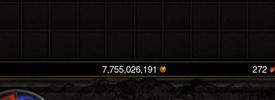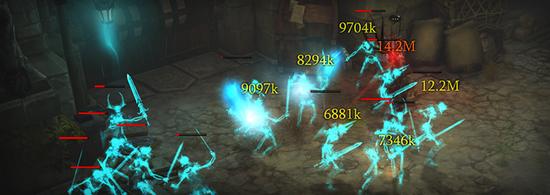Whether you are involved in developing commercial software, entertainment software or your favorite game software, there is not always a simple solution when you encounter problems in the process. As far as game development is concerned, the process is complicated, involving thousands of moving parts. Even the smallest update may take weeks to modify and redo. Non developers may be tempted to ask: "Isn't it all right to fix it?" It's like asking a baker why he doesn't use sugar instead of cyclamate. To this question, the answer of practitioners from all walks of life is similar: "It's not that simple."
How does numbers work?
In Diablo III, players need to receive a large amount of information. Let's just talk about numbers, because numbers are everywhere! There are numbers in the equipment, numbers in the character information, and even more numbers flying in the battle. Behind these figures is a huge amount of technical work. It is these technical works that enable the numbers to be presented to the players in the present way.
We have heard many players' feedback that in the fast-paced battle, there are too many numbers to see, and they disappear before they understand. In the past, when you saw big numbers, you would feel refreshed, because big numbers were very conspicuous and players were very powerful. Now, how can we let players regain this feeling without making them feel weaker?
To solve this problem, we introduced some new features in version 2.4.0. First, we added the option of using abbreviations to display long strings of numbers in the game. Secondly, we have added a new feature that highlights some of the largest damage figures with different colors. When we implemented these new changes in the game, we encountered various challenges. Some are design problems, others are localization problems, and the most important thing is that the final results must be taken care of.

Our original idea was to highlight the highest 5% of the damage numbers played by players in the past few seconds. The first problem of this method is that each skill and equipment are different, especially the way of causing damage. Some of the damage numbers appear in periodic bursts, while others continue to appear. Another problem we encountered at the beginning was that we did not take into account the predictable damage fluctuations. For example, the power tower can temporarily increase the damage significantly, but after the duration is over, you still want to know whether you have caused considerable damage.
In order to solve the above problems, we took time to improve the algorithm, and finally decided to use orange characters to display the rules of damage as follows:
- Damage figures below 10000 will not be considered
- If the number of damage to be displayed is higher than the number displayed with orange last time, the number of damage this time is displayed in orange.
- The value of the maximum number decreases by 3% per second.
- This will reduce the chance of not seeing orange numbers for a long time.
- The first 10 big numbers will not be considered
- This setting allows the system to self calibrate.
- If no damage is caused for 10 seconds, the system resets.
Where have "ten thousand" and "hundred million" gone? -Challenges in localization
If you have played the latest version of the game, you may have noticed that the damage has been abbreviated. Many players from English speaking countries and regions ask why we use "million" instead of "one billion".
There are several reasons for this, but the main reason is localization. Diablo III is a game released worldwide, with 13 language versions. In terms of the design of words (and numbers), we must take into account the games in various languages. Maybe you think it's easy to translate numbers, but actually it's much more complicated than you think.
 Left: Figures in English version. Right: Numbers in Korean version.
Left: Figures in English version. Right: Numbers in Korean version. It can be seen from the above figure that the seemingly simple work is not so simple. In some languages, such as French or Spanish, there is usually no special word for "one billion". The way they express one billion is "one thousand million", not a special word. From the perspective of etymology, the word "billion" first represented "one million million", but in British and American English, the word slowly evolved to represent "one thousand million".
In the Korean version or the Chinese version, the situation is more complicated. In these two languages, large numbers have special names. For example, the naming of numbers in English uses a new expression every three digits, such as "thousand", "million", "billion", and so on. But in Korean, a new expression is used every four digits. Because in South Korea, people are more used to saying "hundreds of thousands" than "hundreds of thousands".
Another problem is the use of punctuation. Not every language has the habit of separating every three digits with a comma. In Europe, periods are more commonly used. Some countries and regions do not use symbols at all.
 Left: Korean gold coin count. Right: Count gold coins in French.
Left: Korean gold coin count. Right: Count gold coins in French. The number in Diablo III is getting bigger and bigger, so we decided to add punctuation for separation, but we have to consider when and where to add punctuation in each language version to ensure the elegance of "translation". Our code uses ICU library, the full name of which is "international unified code component". This library provides a lot of support for software localization. There are many ways to use ICU, but in terms of localization, we use one of the abilities, that is, to input a number, select a region (such as American English, France or South Korea), and let it output a number format that conforms to the usage habits of the selected region, including commas or periods. Our localization team also has a comparison table, which shows the expression of numbers in various regions and the preview of the final results.
|
number
|
Abbreviation (English)
|
Abbreviation (Korean)
|
Abbreviation (Traditional Chinese)
|
Abbreviation (Simplified Chinese)
|
Abbreviation (Europe)
|
| 1 |
1 |
1 |
1 |
1 |
1 |
| 12 |
12 |
12 |
12 |
12 |
12 |
| 123 |
123 |
123 |
123 |
123 |
123 |
| 1,234 |
1234 |
1234 |
1234 |
1234 |
1234 |
| 12,345 |
12,3k |
1.2만 |
12000 |
12,345 |
12,3 |
| 123,456 |
123k |
12만 |
120000 |
123,456 |
123x |
| 1,234,567 |
1,234k |
123만 |
1.23 million |
1,234,567 |
1.234x |
| 12,345,678 |
12,3M |
1234만 |
12.34 million |
12,345,678 |
12,3x |
| 123,456,789 |
123M |
1.2억 |
120 million |
123M |
123x |
| 1,234,567,890 |
1,234M |
12억 |
1.2 billion |
1,234M |
1.234x |
| 12,345,678,901 |
12,345M |
123억 |
12.3 billion |
12,345M |
12.345x |
|
The units of x depend on localization
|
The above is a localization comparison table, which shows the number abbreviation rules of each language.
In different language versions, we choose to use more or less abbreviations according to the situation, mainly because of cultural differences. The length of numbers will affect the psychological satisfaction of players when they see numbers. Different cultures and personalities also affect players' preferences. For example, in the English version, we do not always use abbreviations as long as the number is millions, and we still display the smaller numbers completely. Because "1000000" seems more satisfying than "1M". In the same way, "1000M" seems more satisfying than "1B", so we choose not to use the abbreviation "billion". Of course, we should not only consider the size of the digital size, but also consider the visual effect, color and moving way are all important.
For the simplified Chinese version, we also considered the sense of attack and satisfaction brought by the damage number to the players, taking into account the reading difficulties caused by too long damage numbers, and the effects tested in the actual game. Finally, in the process of national service localization, we chose those numbers less than 100 million to retain the original size and size, which is conducive to bringing satisfaction to players. At the same time, M is used as the unit for damage values greater than 100 million.
Let numbers dance - improve visual effects
When players see a number, it is important to ensure that they immediately understand the number itself and the meaning of the time point when the number appears. In version 2.4.0, our goal is to provide more combat information than before. Therefore, it was decided to highlight the critical hit number.
 Look at that beautiful critical hit!
Look at that beautiful critical hit! Changing colors is a way to present important information. We have racked our brains to show these big figures in the best way. Do you want to make the number bigger? Make their tracks different? Let them shine? Let them stay in the picture for a long time before disappearing? Or is it expressed in different colors? How do we decide which is the best choice?
We finally decided to start with color, because from the perspective of player acceptance, color can highlight the difference of important information. Orange is conspicuous; Players have never seen it before, so they will subconsciously pay more attention to orange numbers.
Orange also passed the color blindness test. Looking at the color circle, we can see that orange is different from the color we currently use to display information. That is to say, color blind players can also identify large numbers displayed in orange!
In terms of changing the interface color, our artists start from three aspects: hue, saturation and brightness. These three are part of the "HSL Color Space", which is the universal digital standard for color circles. Each aspect of regulation can affect players' emotions or cause new emotional reactions. To change the player's mood, just adjust the tone. If you want to make a colorful image less vivid, adjusting saturation is the key. To change the visibility of the image, adjust the brightness.
For example, a crucial piece of information in the game is the amount of treatment the player receives. The therapeutic amount is the vitality, which must be designed to be very conspicuous, so the therapeutic amount number is one of the most luminous information in the game. We also want to design the critical hit number to be very conspicuous, so the brightness of the critical hit number is adjusted very high, so that the player can see the critical hit at a glance.
Let the game become an organic whole
When we talk about the development team of Diablo III, it's easy to first think about how the team can design a profession, item, or add new features for players to explore, because these contents have direct interaction with players and most resonance with players. However, in addition to the player's role equipment, the artists, engineers, localization experts, and countless other staff in our team have worked hard to ensure that global players can get a smooth game experience.
I hope you enjoy this in-depth analysis of injury figures. Although the numbers are small, they are very famous! We are honored to do our part for this game. Even for small details, we are not lazy. This is the end of this article. Thank you!
Sina statement: The purpose of posting this article on Sina.com is to convey more information, which does not mean to agree with its views or confirm its description.





